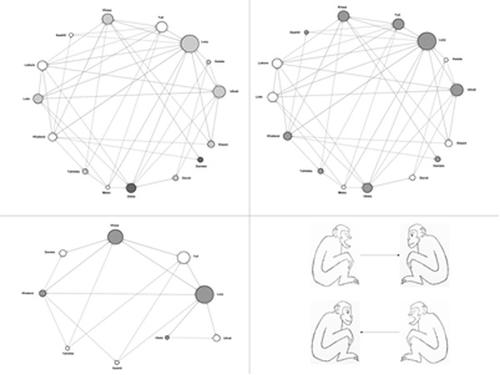当前位置:
X-MOL 学术
›
Am. J. Primatol.
›
论文详情
Our official English website, www.x-mol.net, welcomes your
feedback! (Note: you will need to create a separate account there.)
Yawn contagion in bonobos: Another group, another story
American Journal of Primatology ( IF 2.0 ) Pub Date : 2022-01-31 , DOI: 10.1002/ajp.23366 Ivan Norscia 1 , Marta Caselli 1 , Gabriele De Meo 1 , Giada Cordoni 1 , Jean-Pascal Guéry 2 , Elisa Demuru 3, 4
American Journal of Primatology ( IF 2.0 ) Pub Date : 2022-01-31 , DOI: 10.1002/ajp.23366 Ivan Norscia 1 , Marta Caselli 1 , Gabriele De Meo 1 , Giada Cordoni 1 , Jean-Pascal Guéry 2 , Elisa Demuru 3, 4
Affiliation

|
In primates, yawn contagion (the yawning response elicited by others' yawn) is variably influenced by individual (e.g., sex, age) and social factors (e.g., familiarity) and possibly linked to interindividual synchronization, coordination, and emotional contagion. Two out of three studies on yawn contagion in bonobos (Pan paniscus), found the presence of the phenomenon with mixed results concerning the effect of familiarity and no replication on its modulating factors. To address this puzzling issue, we recorded all occurrences data on yawn contagion in a captive bonobo group (March–June 2021; 18 individuals; La Vallée des Singes, France). Contrary to chimpanzees and humans, the number of triggering yawns increased contagion, possibly owing to a higher stimulus threshold. This aspect may explain the interindividual variability observed in yawn contagion rates. In subjects under weaning, we did not detect yawn contagion and, as it occurs in certain human cohorts, yawn contagion declined with age, possibly due to reduced sensitivity to others. Females responded more than males and elicited more responses from females when showing sexual swelling. As reproductive females are central in bonobo society, our results support the hypothesis that—as in other Hominini—the most influential sex can influence yawn contagion. The relationship quality (measured via grooming/play) did not affect yawn contagion, possibly due to bonobos' xenophilic nature. Overall, this study confirms the presence of yawn contagion in bonobos and introduces new elements on its modulating factors, pointing toward the necessity of cross-group studies.
中文翻译:

倭黑猩猩的哈欠传染:另一个群体,另一个故事
在灵长类动物中,哈欠传染(他人打哈欠引起的哈欠反应)受个体(例如性别、年龄)和社会因素(例如熟悉程度)的不同影响,并可能与个体间的同步、协调和情绪传染有关。三分之二的关于倭黑猩猩(Pan paniscus )哈欠传染的研究),发现这种现象的存在与熟悉程度的影响有关,并且对其调节因素没有复制。为了解决这个令人费解的问题,我们记录了圈养倭黑猩猩群体(2021 年 3 月至 6 月;18 人;法国 La Vallée des Singes)中哈欠传染的所有发生数据。与黑猩猩和人类相反,引发哈欠的次数增加了传染性,这可能是由于更高的刺激阈值。这方面可以解释在哈欠传染率中观察到的个体间变异性。在断奶的受试者中,我们没有检测到哈欠传染,并且由于它发生在某些人类群体中,哈欠传染随着年龄的增长而下降,这可能是由于对他人的敏感性降低。当表现出性肿胀时,女性的反应比男性更多,并且引起了更多女性的反应。由于生殖雌性是倭黑猩猩社会的核心,我们的结果支持这样一个假设,即与其他人类一样,最具影响力的性别可以影响打哈欠的传染。关系质量(通过梳理/玩耍来衡量)不会影响打哈欠的传染,这可能是由于倭黑猩猩的亲外性质。总体而言,这项研究证实了倭黑猩猩中哈欠传染的存在,并在其调节因素上引入了新元素,指出了跨群体研究的必要性。
更新日期:2022-01-31
中文翻译:

倭黑猩猩的哈欠传染:另一个群体,另一个故事
在灵长类动物中,哈欠传染(他人打哈欠引起的哈欠反应)受个体(例如性别、年龄)和社会因素(例如熟悉程度)的不同影响,并可能与个体间的同步、协调和情绪传染有关。三分之二的关于倭黑猩猩(Pan paniscus )哈欠传染的研究),发现这种现象的存在与熟悉程度的影响有关,并且对其调节因素没有复制。为了解决这个令人费解的问题,我们记录了圈养倭黑猩猩群体(2021 年 3 月至 6 月;18 人;法国 La Vallée des Singes)中哈欠传染的所有发生数据。与黑猩猩和人类相反,引发哈欠的次数增加了传染性,这可能是由于更高的刺激阈值。这方面可以解释在哈欠传染率中观察到的个体间变异性。在断奶的受试者中,我们没有检测到哈欠传染,并且由于它发生在某些人类群体中,哈欠传染随着年龄的增长而下降,这可能是由于对他人的敏感性降低。当表现出性肿胀时,女性的反应比男性更多,并且引起了更多女性的反应。由于生殖雌性是倭黑猩猩社会的核心,我们的结果支持这样一个假设,即与其他人类一样,最具影响力的性别可以影响打哈欠的传染。关系质量(通过梳理/玩耍来衡量)不会影响打哈欠的传染,这可能是由于倭黑猩猩的亲外性质。总体而言,这项研究证实了倭黑猩猩中哈欠传染的存在,并在其调节因素上引入了新元素,指出了跨群体研究的必要性。











































 京公网安备 11010802027423号
京公网安备 11010802027423号